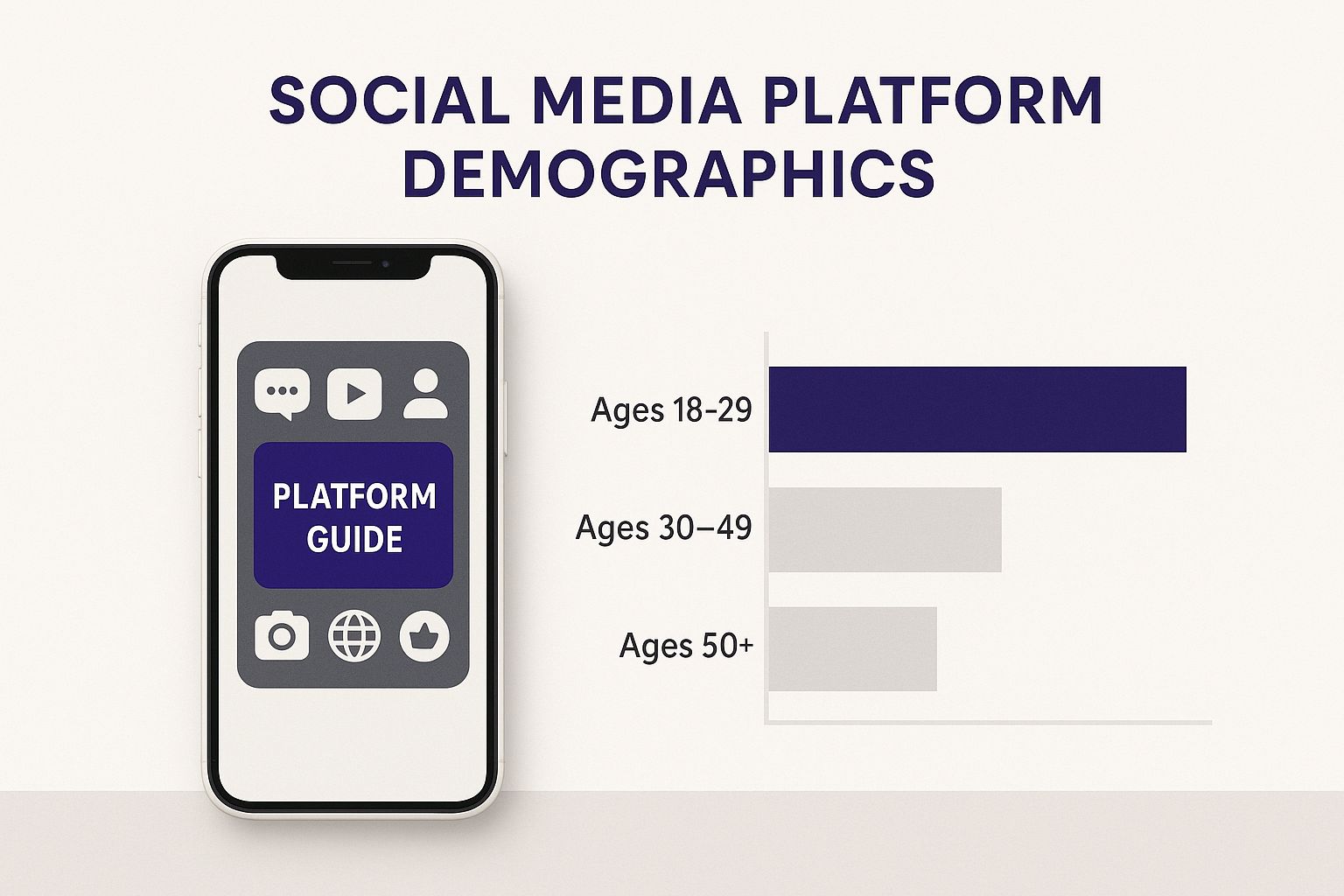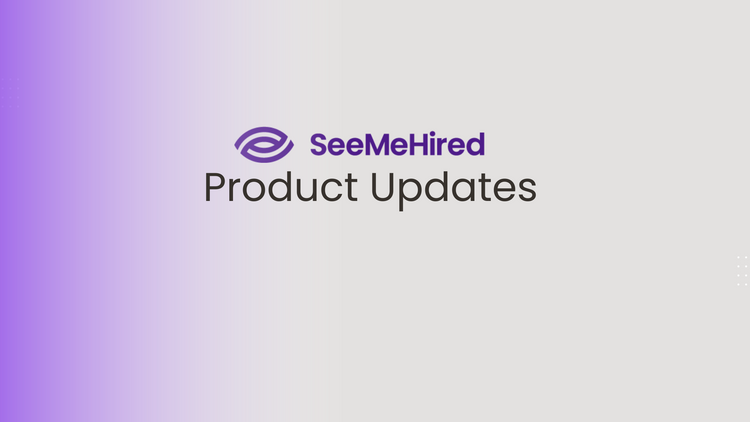SeeMeHired Insights
Social Media for Recruitment: Find Top Talent Fast

Why Most Companies Misstep with Social Media Recruitment
Social media recruitment often resembles a chaotic frontier. Many boast about attracting outstanding candidates on LinkedIn or engaging with Gen Z on TikTok, yet numerous UK companies merely post jobs and hope for the best. Conversations with talent acquisition professionals across the UK reveal that while social media can be effective for recruitment, many are not using it correctly.
Listen to the Podcast Here:
The primary error? Treating social media like a typical job board. It isn't. It's about cultivating genuine relationships, showcasing your company culture, and creating an environment where people want to work. Think of it as dating—you wouldn't propose on the first date, right? You build a connection first. Recruitment is no different.
Another pitfall is focusing too much on vanity metrics. Having thousands of followers might look impressive, but are they the right followers? Are they engaged? Are they potential candidates? Many companies focus on numbers rather than meaningful interaction. It’s akin to having a stadium full of spectators who aren't cheering for your team. What's the point?
The Gap Between Expectation and Reality
This gap between expectation and reality is evident in the numbers. Recruitment data from Q1 2025 in the UK shows that although overall hiring is up, social media only contributed a mere 1% of applications. This figure is actually down from 2% in Q4 2024, whereas recruitment websites and job boards accounted for 9% and 90% respectively. This highlights a substantial disconnect between perceived capabilities of social media recruitment and its actual output. Want to delve deeper into these statistics? Explore more insights on UK recruitment trends.
Changing Your Social Media Approach
So, how do you effectively recruit via social media? It begins with a shift in perspective. Focus less on finding candidates and more on attracting them. Develop a strong employer brand that resonates with your ideal candidates. Engage in real conversations. Provide value beyond just job postings. This long-term strategy might not yield immediate results, but it nurtures a talent pipeline that proves beneficial later on. Think of it like gardening—you need to plant seeds, water them regularly, and be patient before seeing growth. That’s how you turn social media from a loudspeaker into a magnet for top talent.
Transforming LinkedIn Into Your Secret Talent Source

Move beyond merely posting jobs on LinkedIn. Consider it as relationship-building before a vacancy even arises. Leading recruiters in the UK understand this. They actively cultivate a network of potential candidates who are already advocates of their company. So, when a position becomes available, they have a pool of engaged professionals ready to apply.
Enhancing Your Company Page for Success
Your LinkedIn company page should be more dynamic than a static online brochure. It’s often a potential candidate's first impression, so make it impressive. Highlight your company culture with visuals and employee testimonials. Emphasise recent achievements and exciting projects. Focus on why someone would want to work for you, not just what you do.
For instance, move beyond the generic "competitive salary and benefits" narrative. Instead, demonstrate what those benefits mean to your employees. Perhaps share a story about how your flexible work policy improved a team member's work-life balance. That’s the kind of content that resonates.
Also, ensure your page is easily discoverable. Use relevant keywords in your description and content so the right people can find you. Put yourself in a candidate's shoes. What would they search for when looking for a company like yours?
Crafting Content That Attracts Talent
Your company page acts as a magnet, and your content is the attraction. What kind of content will draw in the talent you’re seeking? Share insightful articles related to your industry, celebrate employee successes, and offer a glimpse into your company culture. Authenticity is crucial. Avoid corporate jargon; share genuine stories that connect with people.
This also involves actively engaging with your audience. Respond to comments and questions, participate in industry discussions, and build real connections. This is how you transform from a faceless corporation to a company people want to join. In the UK, social media is essential for recruitment, and LinkedIn, with its growing user base, is leading the charge. As of January 2025, LinkedIn boasts approximately 44.6 million users in the UK. A significant 45% of these users fall within the 25-34 age bracket. Discover more insights on UK social media statistics. This presents a substantial opportunity for recruiters who effectively utilise the platform. Let's explore how LinkedIn demographics can impact your recruitment efforts.
To illustrate the opportunities within LinkedIn's UK user base, consider the table below:
LinkedIn Demographics and Recruitment Opportunities
Breakdown of LinkedIn user demographics in the UK and their recruitment potential
| Age Group | Percentage of Users | Career Stage | Recruitment Opportunities |
|---|---|---|---|
| 25-34 | 45% | Mid-Career/Experienced Professionals | High potential for specialised roles and leadership positions. Focus on content showcasing career growth and challenging projects. |
| 35-54 | 35% | Senior/Executive Level | Ideal for senior management roles and specialised expertise. Emphasise leadership opportunities, work-life balance, and impactful projects. |
| 18-24 | 15% | Entry-Level/Recent Graduates | Great for entry-level positions and internships. Focus content on company culture, training programmes, and career development opportunities. |
| 55+ | 5% | Senior/Experienced/Consultants | Valuable source for specialised expertise and consulting roles. Highlight flexible work arrangements and opportunities to mentor younger professionals. |
This table demonstrates how understanding LinkedIn's demographics can help tailor your recruitment strategy. Focusing on the most relevant age groups and career stages can significantly improve your chances of finding the right fit.
Mastering LinkedIn's Search and Messaging Features
LinkedIn's search function is incredibly useful for identifying passive candidates—those not actively seeking a job, but open to the right opportunity. Use Boolean search strings to refine your search and locate professionals with particular skills and experience.
Once you've identified potential candidates, personalise your messages. Show that you've actually reviewed their profile. Generic messages tend to be ignored. Mention something specific that caught your attention. It could be a shared connection, a piece of content they created, or a relevant skill they possess. This demonstrates genuine interest and increases the likelihood of a response. Building a strong LinkedIn presence takes time, but it’s an investment that pays dividends. It's about positioning yourself as an employer of choice and developing a talent pipeline that supports your company's growth.
Beyond LinkedIn: Untapped Talent on Twitter and Instagram
Many recruiters overlook a wealth of talent by dismissing platforms they perceive as "too casual." While the competition is fierce on LinkedIn, savvy companies are quietly cultivating fantastic talent pipelines on Twitter and Instagram. They showcase their true workplace culture and attract individuals who connect with their values and ethos.

This infographic highlights the importance of selecting the right platforms for your recruitment strategy. Having a clear plan for each social media platform is crucial, as each has its own strengths and attracts a different audience.
Succeeding on Twitter: Thought Leadership and Strategic Hashtags
Twitter is all about genuine engagement and being part of the conversation. Companies have thrived on Twitter by sharing insightful industry perspectives and engaging in relevant discussions. Don’t just post job ads; become a voice that people want to follow. For instance, if you're aiming to attract talented software developers, share articles about new technologies or participate in coding challenges.
Hashtags are very effective tools, but they should be used wisely. Too many can make you seem desperate. A few well-chosen hashtags can significantly expand your reach. Take time to research relevant hashtags in your industry across the UK. For example, avoid the generic #jobs and try #UKTechJobs or #LondonMarketingJobs for more targeted exposure.
Instagram: Highlighting Company Culture and Daily Life
Instagram is where you can truly showcase your company culture. Avoid polished corporate photos. Provide behind-the-scenes insights into team lunches, employee spotlights, or even "a day in the life" of someone in a specific role. I once worked with a company that excelled at Instagram "employee takeovers" to demonstrate what it was really like to work there. Candidates appreciated it! They could finally see the human side of the business.
Instagram Stories are another excellent way to share quick updates, job openings, or more behind-the-scenes content. They’re engaging and vanish after 24 hours, creating a sense of urgency. Use polls and Q&As to directly interact with your audience and build genuine relationships with potential candidates. This article from SeeMeHired has additional tips: Social Media in Recruiting: Boost Your Hiring Strategy.
To help you visualise the strengths of each platform, let’s examine this comparison:
Social Media Platform Comparison for Recruitment
Detailed comparison of major social platforms for recruitment effectiveness and use cases
| Platform | Best For | Candidate Demographics | Engagement Style | Success Metrics |
|---|---|---|---|---|
| Professional networking, targeted recruitment | Professionals across all industries | Formal, professional, industry-focused | Profile views, connection requests, InMail responses, applicant quality | |
| Building industry presence, engaging with potential candidates | Tech-savvy professionals, active users interested in industry news and discussions | Conversational, real-time engagement, thought leadership | Retweets, likes, comments, follower growth, website clicks | |
| Showcasing company culture, attracting younger talent | Visually-oriented candidates, younger demographics, those seeking a strong company culture fit | Visual storytelling, behind-the-scenes content, employee spotlights | Likes, comments, shares, story views, follower growth |
As illustrated, each platform offers a unique means to connect with potential candidates. Selecting the right combination for your specific needs will enhance your recruiting efforts.
Evaluating Emerging Platforms
New social media platforms frequently emerge. It's tempting to explore every new trend, but it’s wise to focus your efforts where your target audience already spends their time. Before investing time and resources into a new platform, consider these key questions:
Is my ideal candidate actually using this platform?
What kind of content performs well here?
Do I have the resources to maintain a consistent presence?
By strategically using Twitter and Instagram, and carefully assessing other options, you can tap into a hidden pool of talented individuals. It’s all about building authentic connections and showcasing the human side of your company – that’s what truly attracts great people.
Timing Strategies That Deliver Results
Timing is a crucial element in recruitment that often goes unnoticed. Posting on social media isn't just about when people are online; it’s about when they’re most receptive to new opportunities. Understanding this can greatly influence the success of a campaign. Think of it as discovering the perfect moment when your content naturally appears before the right audience.
Understanding the Social Media Habits of UK Professionals
UK professionals spend an average of 1 hour and 17 minutes on social media during work each day. This is more than a distraction – it’s an opportunity. While scrolling, they’re often contemplating their careers, even subconsciously. Your content should feel like a valuable part of their feed, not an interruption. Focusing on genuine engagement, rather than hard selling, works best here. Interestingly, about 10% spend over 4 hours on social media daily at work. This represents a substantial pool of potential candidates ready to be reached. This article delves into UK social media usage at work. Understanding these habits forms the basis of a smart timing strategy.
Seasonal Trends and Strategic Planning
Recruitment, like many sectors, experiences peaks and troughs. The new year typically brings a surge of job seekers, while summer tends to be quieter. Savvy recruiters leverage these trends. During peak hiring seasons, ramp up activity, and focus on building relationships and engagement during quieter periods. Consider it like planting seeds in the off-season to prepare for growth when conditions are optimal. Interested in speeding up your hiring process? Check out this article: Reduce Time to Hire: 8 Strategies to Speed Up Recruitment. Aligning your social media calendar with your broader hiring strategy is key to maximising your impact.
Consistency Without Excess
Consistency is crucial, but avoid overwhelming your audience with excessive posts. Nobody wants to see multiple posts a day from the same company. A well-organised content calendar is invaluable here. It maintains a steady presence without overwhelming followers. In my experience, one well-crafted, engaging post per day is more effective than numerous generic ones. Quality over quantity is key. Schedule your posts in advance to hit those optimal times.
Testing and Refining Your Approach
The secret to perfect timing? Experimentation! Try posting at various times on different days. Be open to variations. Observe what resonates with your target audience. Which posts garner the most likes, comments, and shares? More importantly, which ones lead to applications? This data is invaluable. Use it to refine your strategy and enhance your results. What works for one company may not work for another. The goal is to find what works best for you.

Building an Employer Brand That Draws Talent
Your employer brand is what distinguishes you in a crowded job market. It's not just about perks and salary—it’s the complete experience you offer. In today's UK market, companies succeeding in the talent competition are those creating environments people want to join. This involves using social media not just to post jobs, but to build a brand that attracts top talent.
Creating Genuine Content
Avoid corporate jargon. Instead, present your true company culture through authentic content. Consider what makes your workplace unique. Is it the flexible hours? The amazing team? The development opportunities? Integrate these elements into your social media narrative.
For example, skip the typical boardroom photo. Share a picture of your team enjoying a Friday lunch. Showcase the human side of your company. Share employee stories and celebrate their achievements. Allow potential candidates to envision themselves thriving in your environment.
Employee Advocacy: Transforming Your Team Into Brand Ambassadors
Your employees are your best asset for employer branding. Develop an employee advocacy programme that encourages them to share their positive experiences on social media. Their genuine voices are far more influential than any corporate message. Let them express what they love about working for you.
Job Descriptions That Inspire
Job descriptions shouldn’t be dull lists of requirements. They should be an invitation! Craft descriptions that capture the excitement of the role and the opportunities it presents. Highlight the impact the candidate can have and how they can grow. Make people eager to apply.
LinkedIn is an excellent example. Check out their company page:
They effectively use their platform to highlight their culture, values, and employee experiences. They share employee stories, celebrate successes, and provide a real insight into what it’s like to work there. It's a textbook example of using social media for recruitment. For more tips, see this article: How to Build a Strong Employer Brand and Attract Better Talent.
Managing Negative Feedback
Negative feedback is inevitable. Don’t ignore it. Address it directly with honesty and empathy. Respond constructively to criticism and demonstrate that you’re listening. This shows potential candidates that you value feedback and are committed to improvement.
Measuring Your Success
How do you know your employer branding is effective? Track relevant metrics. Are you receiving more qualified applicants? Are employee referral rates increasing? Is your social media content engaging? These are indicators that you’re building a brand that resonates. Remember, the aim isn't to chase candidates, but to create an attraction that draws them in.
Focusing on Metrics That Matter: Analytics for Better Decisions
Are you overwhelmed with social media metrics? Likes, shares, comments... but are they leading to quality hires? Vanity metrics are entertaining, but they don't fill vacancies. Let’s focus on data that truly impacts social media recruitment in the UK.
From Engagement to Conversions: Monitoring What Truly Matters
High engagement indicates real interest. It means people aren’t just scrolling past—they’re stopping, clicking, commenting, and sharing. That’s valuable. Consider this: a thoughtful comment on your LinkedIn post holds more value than a fleeting like. Then there's conversion tracking. This reveals which platforms and content pieces actually lead to applications. Are your Instagram Stories driving more traffic to your careers page than your LinkedIn posts? The data narrates the story. This allows you to focus on what works and abandon what doesn’t.
Attribution: Linking Social Media Efforts to Hires
This is where it becomes interesting: attribution. This involves understanding which of your social media activities are directly responsible for attracting top-tier candidates. It's like detective work, tracing a successful hire back to the initial interaction. Did they first discover your company through a Twitter chat? Or was it an engaging Instagram Reel? Identifying this empowers you to make informed decisions about where to invest time and budget. You might find this helpful: How to Create an Outstanding Candidate Experience.
Using Data to Improve and Demonstrate ROI
Insights from social media are invaluable for refining your targeting. Are you reaching the right demographics in the UK? Is your messaging effective? The data will guide you. It’s also essential for optimising your content strategy. What type of content generates the most engagement and conversions? Experiment with various formats, topics, and posting times. Let the data lead the way. Additionally, data helps demonstrate the ROI of your social media recruitment efforts. This is crucial for gaining support from stakeholders who may not yet be convinced. Hard numbers are always persuasive.
A/B Testing and Quality Control
A/B testing is another valuable tool. Test different versions of your recruitment posts to see what resonates best with potential candidates. Does a video outperform a static image? Does a casual tone work better than a formal one? Test, test, test! Let the data decide. And remember, it’s not just about the number of applications. Quality matters too. Are you attracting top talent, or just a flood of unqualified applicants? Refine your strategy accordingly.
Real-World Examples and Practical Tools
I've witnessed how data-driven decisions can transform social recruitment outcomes. One company I worked with saw a 30% increase in qualified applications by adjusting their LinkedIn posting schedule based on engagement data. They identified when their target audience was most active and adapted their strategy. Simple, but effective.
Finally, the right tools are crucial. There are numerous platforms for monitoring social media recruitment performance, from straightforward analytics dashboards to sophisticated social listening tools like Brand24. Find what suits your needs and budget. The key is using data not just to measure, but to improve. That’s how you transform social media from a guessing game into a robust recruitment engine.
Your Social Media for Recruitment Action Plan
Ready to elevate your social media recruitment strategy? Excellent! Whether you’re just beginning or refining your current approach, think of this as a flexible guide. It’s not a rigid template, but a roadmap you can adapt to your company’s unique needs and resources. For a broader perspective on UK recruitment, our guide on The Top UK Job Boards and Hiring Platforms to Find Talent in 2024 could be helpful.
Setting Realistic Timelines and Budgets
Firstly, let’s be realistic. Building a successful social media recruitment strategy takes time. If you’re a small business, you won’t have the same resources as a large corporation, and that’s perfectly okay. Begin small and focused. Choose one or two platforms where your ideal candidates are most active. Don’t attempt to be everywhere at once. It's a recipe for burnout!
Regarding budget, social media recruitment can be surprisingly cost-effective. Many platforms offer free accounts, and even paid advertising can be highly targeted. This means you’re only spending money reaching people truly interested in what you offer. My advice? Focus on organic growth initially. Build a genuine presence and then consider paid campaigns once you’ve established a solid foundation.
Templates and Frameworks for Success
In my experience, having clear guidelines and policies in place is absolutely essential. A social media recruitment policy ensures everyone is on the same page and helps avoid any awkward missteps (we’ve all seen those social media fails!). A content calendar is your secret weapon for consistent posting without feeling overwhelmed. And a robust performance tracking framework—one that focuses on tangible results, not just vanity metrics like likes and shares—helps you measure what truly matters. Remember, we’re aiming to improve on that 1% of applications coming from social media. We can definitely do better!
Sustainable Practices and Measurable Milestones
This isn’t a sprint, it’s a marathon. Focus on building sustainable practices that deliver consistent results over time. Don’t exhaust yourself trying to do everything at once. Set achievable milestones so you can celebrate your progress and stay motivated. Did you just secure a fantastic candidate through a Twitter connection? That’s a win! Are you building a thriving community on LinkedIn? Another win! These small victories accumulate to significant results in the long run.
Looking to streamline your entire hiring process and boost your social media recruitment? SeeMeHired offers a comprehensive platform that simplifies everything from attracting candidates to onboarding new hires. Learn more about how SeeMeHired can transform your recruitment strategy.

























